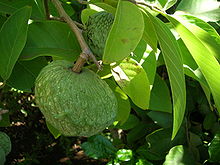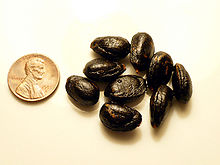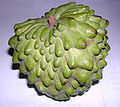- Annona
-
For other uses, see Annona (disambiguation).
Annona 
Sugar-apple (Annona squamosa) 
Scientific classification Kingdom: Plantae (unranked): Angiosperms (unranked): Magnoliids Order: Magnoliales Family: Annonaceae Genus: Annona
L.[1]Species Some 100-150, see text.
Synonyms Guanabanus Mill.
Raimondia Saff.
Rollinia A. St.-Hil.
Rolliniopsis Saff.[2]Annona is a genus of flowering plants in the pawpaw/sugar apple family, Annonaceae. It is the second largest genus in the family after Guatteria,[3] containing approximately 110 species of mostly neotropical and afrotropical trees and shrubs.[4] The generic name derives from anón, a Hispaniolan Taíno word for the fruit.[5] Paleoethnobotanical studies have dated Annona exploitation and cultivation in the Yautepec River region of Mexico to approximately 1000 BC.[6]
Currently, seven Annona species and one hybrid are grown for domestic or commercial use, mostly for the edible and nutritious fruits; several others also produce edible fruits.[7] Many of the species are used in traditional medicines for the treatment of a variety of diseases. Several annonacaeous species have been found to contain acetogenins, a class of natural compounds with a wide variety of biological activities.[8][9]
Contents
Description
Annona species are taprooted, evergreen or semideciduous, tropical trees or shrubs.[4] This fruit typically grows in areas which do not get below 28 degrees; Cuba, Jamaica, and the Philippines, however it has been known to grow in certain areas of Florida.
- Trunks: The trunks have thin bark that has broad and shallow depressions or fissures which join together and are scaly giving rise to slender, stiff, cylindrical and tapering shoots with raised pores and naked buds.[4]
- Leaves: Leaf blades can be leathery or thin and rather soft or pliable, bald or hairy.[4]
- Flowers: The flowering stalks rise from axils, or occasionally from axillary buds on main stems or older stems, or as solitary flowers or small bundle of flowers. Usually, the three or four deciduous sepals are smaller than the outer petals that do not overlap while in bud. Six to eight fleshy petals in two whorls—the petals of the outer whorl are larger and do not overlap; inner petals are ascending and distinctively smaller, and nectar glands are darker pigmented. Numerous stamens that are ball, club-shaped, or curved and hooded or pointed beyond anther sac. Numerous pistils, attached directly to the base, are partially united to various degrees with distinct stigma, with one or two ovules per pistil; the style and stigma are club-shaped or narrowly conic.[4]
- Fruits: One fleshy, ovate to spherical fruit is produced per flower. Each fruit consists of many individual small fruits or syncarps, with one syncarp and seed per pistil. Seeds are bean-like with tough coats; the seed kernels are toxic.[4]
- Pollination: Dynastid scarab beetles appear basic within the genus Annona. Those species of Annona which are more morphologically derived, as well as all Rollinia spp., possess reduced floral chambers and attract small beetles such as Nitidulidae or Staphylinidae.[10]
Images
-
Atemoya (A. cherimola × A. squamosa)
-
Cherimoya (A. cherimola) plantation
-
Sugar apples (A. squamosa)
-
Custard apple (A. reticulata) interior
Selected species
The following is a list of some of the more important species. Many of them have significant agricultural, medicinal, pharmaceutical, and other uses. Synonyms appear in the sublist.[11]
- Annona amambayensis
- Annona acuminata
- Annona ambotay
- Annona asplundiana
- Annona atabapensis
- Annona × atemoya – atemoya
- Annona bullata
- Annona biflora
- Annona bicolor
- Annona brasililensis
- Annona cacans - – ariticum ou çoriticaos
- Annona calophylla
- Annona campestris
- Annona cherimola – cherimoya
- Annona chrysophylla – graines
- Annona pubescens
- Annona tripetala
- Annona conica
- Annona coriacea
- Annona cornifolia
- Annona crassiflora – araticum do cerrado, marolo
- Annona cristalensis
- Annona crotonifolia
- Annona deceptrix
- Annona deminuta
- Annona dioica
- Annona diversifolia – ilama
- Annona dolabripetala
- Annona dolichophylla
- Annona echinata
- Annona ecuadorensis
- Annona ekmanii
- Annona excellens
- Annona glabra – pond apple, alligator apple, monkey apple
- Annona palustris
- Annona glaucophylla
- Annona haematantha
- Annona hayesii
- Annona hypoglauca
- Annona hystricoides
- Annona jahnii
- Annona jamaicensis
- Annona longiflora
- Annona lutescens
- Annona macrocalyx
- Annona malmeana
- Annona manabiensis
- Annona microcarpa
- Annona montana Macfad. – mountain soursop
- Annona marcgravii Mart.
- Annona monticola
- Annona muricata – soursop, guanábana
- Annona macrocarpa auct.
- Annona nutans
- Annona oligocarpa
- Annona paludosa
- Annona paraguayensis
- Annona phaeoclados
- Annona praetermissa
- Annona purpurea – sonconya
- Annona pygmaea
- Annona reticulata – custard apple, bullock's heart, corazón
- Annona salzmannii – beach sugar apple
- Annona scleroderma – poshe-te, cawesh , wild red custard apple
- Annona senegalensis – African custard apple
- Annona sericea
- Annona spinescens
- Annona spraguei
- Annona squamosa – sugar apple, sweetsop, anón
- Annona testudinea
- Annona tomentosa – aritcum de moita
- Annona trunciflora – golden sugar apple, false sonconya
Insects and diseases
Annona species are generally disease-free. They are susceptible to some fungi and wilt. Ants are a problem, since they promote mealy bugs on the fruit.[12]
- Insects
- Braephratiloides cubense (annona seed borer)
- Bepratelloides cubense (annona seed borer)[13][14]
- Morganella longispina (plumose scale)
- Philephedra n.sp. (Philephedra scale)
- Pseudococcus sp. (mealy bugs)
- Xyleborus sp. (ambrosia beetles)[13]
- Ammiscus polygrophoides
- Anastrepha atrox
- Anastrepha barandianae
- Anastrepha bistrigata
- Anastrepha chiclayae
- Anastrepha disticta
- Anastrepha extensa
- Anastrepha fraterculus
- Anastrepha oblicua
- Anastrepha serpentina
- Anastrepha striata
- Anastrepha suspensa
- Apate monachus
- Bactrocera spp.
- Bephrata maculicollis
- Brevipalpus spp.
- Ceratitis capitata
- Cerconota anonella
- Coccoidea spp.
- Coccus viridis (green scale)
- Emanadia flavipennis
- Gelwchiidae spp.
- Heliothrips haemorphoidalis
- Leosynodes elegantales
- Lyonetia spp.
- Oiketicus kirby
- Orthezia olivicola
- Phyllocnistis spp.
- Pinnaspis aspidistrae
- Planococcus citri
- Saissetia nigra
- Talponia spp.
- Tenuipalpidae
- Tetranynchus spp.
- Thrips[15]
- Fungi
- Armillaria (oak root fungus)
- Ascochyta cherimolaer
- Botryodiplodia theobromae
- Cercospora annonaceae
- Cladosporium carpophilum
- Colletotrichium spp.
- Colletotrichium annonicola
- Colletotrichum gloeosporioides
- Corticium salmonicolor
- Fumagina spp.
- Fusarium solani
- Gloeosporium
- Glomerella cingulata
- Isariopsis anonarum
- Koleroga noxis
- Monilia
- Nectria episphaeria
- Oidium
- Phakopsora cherimolae
- Phomopsis spp.
- Phomopsis annonacearum
- Phyllosticta
- Phythium spp.
- Phytophtora palmivora
- Phytophtora parasitica
- Rhizopus nigricans
- Rhizopus stolonifer
- Rhizoctonia spp.
- Rhizoctonia solani
- Salssetia oleare
- Sclerotium rolfsii
- Uredo cherimola
- Verticillium (wilt)
- Zignoella annonicola[12][15]
- Nematodes
- Cephalobidae spp.
- Dorylaimidae spp.
- Gracilacus spp.
- Helicotylenchus spp.
- Hemicycliophora spp.
- Hoplolaimidae spp.
- Meloidogyne incognita spp.
- Pratylenchus spp.
- Paratylenchus micoletzky. Rhabditis spp.
- Tylenchorhynchus spp.
- Xiphinema americanum [15]
- Algae
- Cephaleuros virescens
- Cephalosporium spp.
- Paecilomyces spp.[15]
- Diseases
References
- ^ Natural Resources Conservation Service (NRCS). "PLANTS Profile, Annona L.". The PLANTS Database. United States Department of Agriculture. http://plants.usda.gov/java/profile?symbol=ANNON. Retrieved 2008-04-16.
- ^ Germplasm Resources Information Network (GRIN) (1996-09-17). "Genus: Annona L.". Taxonomy for Plants. USDA, ARS, National Genetic Resources Program, National Germplasm Resources Laboratory, Beltsville, Maryland. http://www.ars-grin.gov/cgi-bin/npgs/html/genus.pl?720. Retrieved 2008-04-18.
- ^ "Annona". Integrated Taxonomic Information System. http://www.itis.gov/servlet/SingleRpt/SingleRpt?search_topic=TSN&search_value=18095. Retrieved 2008-04-16.
- ^ a b c d e f Flora of North America. 1. Annona Linnaeus, Sp. Pl. 1: 536. 1753; Gen. Pl. ed. 5, 241, 1754. 3. http://www.efloras.org/florataxon.aspx?flora_id=1&taxon_id=101891. Retrieved 2008-04-20.
- ^ Austin, Daniel F. (2004). Florida Ethnobotany. CRC Press. p. 95. ISBN 9780849323324. http://books.google.com/?id=eS7lX_rC3GEC.
- ^ Warrington, Ian J. Warrington (2003). "Annonaceae". Apples: Botany, Production and Uses. CABI Publishing. ISBN 0851995926. http://books.google.com/books?id=AxbUJntXepEC&pg=PA74&lpg=PA74&source=web&ots=huvTs57P4I&sig=1AECuDjdwZa8qHmb-hEY-69PwzE&hl=en#PPA74,M1. Retrieved 2008-04-20.
- ^ University of Southampton (March 2002). "Factsheet No. 5. Annona" (PDF). Fruits for the Future. Department for International Development, International Centre for Underutilised Crops. http://www.icuc-iwmi.org/files/News/Resources/Factsheets/annona.pdf. Retrieved 2008-04-20.
- ^ Pilar Rauter, Amélia; A. F. Dos Santos and A. E. G. Santana (2002). "Toxicity of Some species of Annona Toward Artemia Salina Leach and Biomphalaria Glabrata Say". Natural Products in the New Millennium: Prospects and Industrial Application. Springer Science+Business Media. pp. 540 pages. ISBN 1402010478. http://books.google.com/books?id=4rrC7c_6OUoC&pg=PA264&lpg=PA264&source=web&ots=GVwQsxA_oK&sig=9U5mL2oGo14l_K6XnC8wb8k1a_M&hl=en. Retrieved 2008-04-20.
- ^ Esposti, M Degli; A Ghelli, M Ratta, D Cortes, and E Estornell (1994-07-01). "Natural substances (acetogenins) from the family Annonaceae are powerful inhibitors of mitochondrial NADH dehydrogenase (Complex I)". The Biochemical Journal (The Biochemical Society) 301 (Pt 1): 161–7. PMC 1137156. PMID 8037664. http://www.pubmedcentral.nih.gov/articlerender.fcgi?tool=pmcentrez&artid=1137156.
- ^ Gottsberger, Gerhard (28 April 1988). "Comments on flower evolution and beetle pollination in the genera Annona and Rollinia (Annonaceae)". Plant Systematics and Evolution (Springer Science+Business Media) 167 (3–4): 189–194. doi:10.1007/BF00936405. http://www.springerlink.com/content/u03w164g12876313/. Retrieved 2008-04-20.
- ^ Germplasm Resources Information Network (GRIN). "GRIN Species Records of Annona". Taxonomy for Plants. USDA, ARS, National Genetic Resources Program, National Germplasm Resources Laboratory, Beltsville, Maryland. http://www.ars-grin.gov/cgi-bin/npgs/html/splist.pl?720. Retrieved 2008-04-16.
- ^ a b Robert Vieth, Master Gardener. "Cherimoya". Minor subtropicals. Ventura County Cooperative Extension. http://ucce.ucdavis.edu/counties/ceventura/Agriculture265/Cherimoya.htm. Retrieved 2008-04-20.
- ^ a b c Jorge Pena and Freddie Johnson (October 1993). "Insect Pests of Annona Crops" (PDF). Other Fruits With Insecticides Known to Have Labels for Use. Department of Entomology, University of Florida. http://edis.ifas.ufl.edu/pdffiles/IG/IG07900.pdf. Retrieved 2008-04-19.
- ^ Jonathan H. Crane, Carlos F. Balerdi, and Ian Maguire (April 1994). "Sugar Apple Growing in the Florida Home Landscape". Fact Sheet HS38. Institute of Food and Agricultural Sciences, University of Florida. http://edis.ifas.ufl.edu/MG330. Retrieved 2008-04-19.
- ^ a b c d Bridg, Hannia (2001-05-03). "Micropropagation and Determination of the in vitro Stability of Annona cherimola Mill. and Annona muricata L.". Zertifizierter Dokumentenserver der Humboldt-Universität zu Berlin. http://edoc.hu-berlin.de/dissertationen/bridg-hannia-2000-03-24/HTML/brigd-ch1.html. Retrieved 2008-04-20.
External links
 Media related to Annona at Wikimedia Commons
Media related to Annona at Wikimedia Commons Data related to Annona at Wikispecies
Data related to Annona at Wikispecies- Type Collections of Neotropical Annonaceae - Annona — has pictures and details on these and other Annona species
Wikimedia Foundation. 2010.









